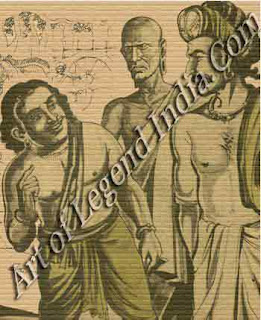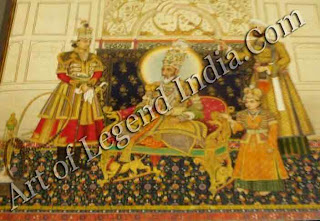 The Pallavas of Kanchi
represent an early dynasty in South India. Simhavishnu's son Mahendravarman I
was the king of this line who first introduced rock-cut architecture in the
Tamil area. Mahendravarman descended from the Vishnukundins through his mother.
As a young prince, Mahendravarman was no doubt impressed by the art of the
Vishnukundins at Vijayawada. This should account for the great similarity
between the rock-cut temples at Mogalrajapuram and those of Mahendravarman in
the Tamil country. His famous inscription at Mandagapattu etad anishtakam adru
man alauhain asudham vichitrachittena nirmapitam nripena
brahmesvaravishnulakshitayatanam shows that for the first time the rock-out
temple was achieved without the necessity of erecting a shrine with bricks,
wood, metal or mortar.
The Pallavas of Kanchi
represent an early dynasty in South India. Simhavishnu's son Mahendravarman I
was the king of this line who first introduced rock-cut architecture in the
Tamil area. Mahendravarman descended from the Vishnukundins through his mother.
As a young prince, Mahendravarman was no doubt impressed by the art of the
Vishnukundins at Vijayawada. This should account for the great similarity
between the rock-cut temples at Mogalrajapuram and those of Mahendravarman in
the Tamil country. His famous inscription at Mandagapattu etad anishtakam adru
man alauhain asudham vichitrachittena nirmapitam nripena
brahmesvaravishnulakshitayatanam shows that for the first time the rock-out
temple was achieved without the necessity of erecting a shrine with bricks,
wood, metal or mortar.  The Pallavas of Kanchi
represent an early dynasty in South India. Simhavishnu's son Mahendravarman I
was the king of this line who first introduced rock-cut architecture in the
Tamil area. Mahendravarman descended from the Vishnukundins through his mother.
As a young prince, Mahendravarman was no doubt impressed by the art of the
Vishnukundins at Vijayawada. This should account for the great similarity
between the rock-cut temples at Mogalrajapuram and those of Mahendravarman in
the Tamil country. His famous inscription at Mandagapattu etad anishtakam adru
man alauhain asudham vichitrachittena nirmapitam nripena
brahmesvaravishnulakshitayatanam shows that for the first time the rock-out
temple was achieved without the necessity of erecting a shrine with bricks,
wood, metal or mortar.
The Pallavas of Kanchi
represent an early dynasty in South India. Simhavishnu's son Mahendravarman I
was the king of this line who first introduced rock-cut architecture in the
Tamil area. Mahendravarman descended from the Vishnukundins through his mother.
As a young prince, Mahendravarman was no doubt impressed by the art of the
Vishnukundins at Vijayawada. This should account for the great similarity
between the rock-cut temples at Mogalrajapuram and those of Mahendravarman in
the Tamil country. His famous inscription at Mandagapattu etad anishtakam adru
man alauhain asudham vichitrachittena nirmapitam nripena
brahmesvaravishnulakshitayatanam shows that for the first time the rock-out
temple was achieved without the necessity of erecting a shrine with bricks,
wood, metal or mortar.
The king bore such titles as
Vichitrachitta the curious art-minded one, Chitrakarapuli a tiger among
painters, Mattavilasa, Chaityakari and so forth. His titles suggest his
artistic taste. He was an architect, an engineer, a poet an artist all in one.
His son Narasimhavarman I, who was probably amongst the greatest conquerors of
his day and ranked with Pulakesin and Harsha, his two great contemporaries,
created monuments that are even .today gazed on with wonder by connoisseurs. Towards
the end of the seventh century, the Kailasanatha temple at Kanchipuram was
constructed by another great Pallava king, Rajasimha, who was aided in this by
his art-minded queen, Rangapataka. The paintings in the monuments of this king
give us splendid examples, though not many, of the Pallava phase of painting.
The traces of line and colour
in cave temples like those at Mamandur show what a great phase of painting of
the time of Mahendravarman is now almost lost. In the structural Pallava
temples at Panamalai and Kanchipuram, there are fragments which give us a
glimpse of the development of painting a few decades after Mahendravarman.
These were discovered by Professor Dubreuil. The beautiful goddess, with a
crown on her head and umbrella held over her, from Panamalai, the charming
remains of a princely figure and a Somaskanda from two of the cloister cells
surrounding the courtyard of the Kailasanatha temple at Kanchipuram, show the
painter's art of Rajasimha's time.
Though fragmentary, the painting
representing Somaskanda has still enough to indicate the wonderful flourish in
the lines composing figures of seated Siva and Parvati with baby Skanda in the
centre and the gana follower of Siva on one side at his foot and a charming attendant of Parvati beside her at the edge of her seat. When we
recall that the Somaskanda theme was a great favourite in Pallava art and that
this is the only representation of it in a painting, preserved for us of this
period, we may very well appreciate how important this is for a study of
Pallava art. It is a lovely theme of a fond parent and frolicsome child, of the
ideal mates and the object of their love, philosophy of affection spent on the
offspring but increasing ever more.
The lines composing these figures
are fragmentary and yet there is enough left in them to make out the Somaskanda
group. Siva is seated, his right leg lowered down and the left bent on the
seat. The jatamakuta is lost, the curve of the face and the ear-lobes suggest
what a beautiful part has been lost. The torso shows the perfection of con-tour
at its best, the upper hands are more suggestive than complete; but the lovely
palm of the lower left nestling on the lap makes up for all that is lost of the
lower right of which the fingers alone remain. The yajnopavita flowing in a
curve and hanging in tassels is matched only by the elaborate girdle and the
pleasing folds of the silken garments. Keyuras, wristlets and udarabandha
complete a most pleasing arrangement of jewelry. The baby beside him, Skanda,is a noble representation of the age of innocence. A tiny coronet adorns the
juvenile head. From his mother's lap, he looks at his father meaningfully. The
mother of this pretty little child is a painter's dream, a marvel of brush
work, a delicate subject treated softly and sweetly. She is seated on a couch
with her right leg on her seat and the left hanging down to rest on a cushioned
footstool which is lost. The face of Uma is obliterated and we can only imagine
its beauty with a gem-decked crown and a flower-filled braid. Her right hand
caresses the child, the left rests on the seat.
The full breasts, the
attenuated waist and the broad hips supply a contour to the form that idealises
feminine grace. The pendant, which is all that is left of a necklet, is in a
place where beauty of form beautifies beauty of ornament. Armlets and various
types of bracelets are present. The elaborate girdle with its manifold tassels
flowing down the sides of the couch like tiny silver streamlets descending in little
cascades is a piece of work of which any master would be proud. The silken
garment worn by the goddess shows a pleasing pattern worked on it. At their
feet on either side, an attendant is shown, the one nearer Siva, uddhata or
forceful and the other nearer Uma, lalita or soft type. There is a strange
tinge of intelligence and calm in the gana nearer Siva and a soft look may be
seen in the sweet face of the one near the Lord's consort.
Writer
C. Sivaramamurti
Subscribe to:
Post Comments (Atom)












0 Response to "Pallava Emperor "Seventh to Ninth Century A.D.""
Post a Comment